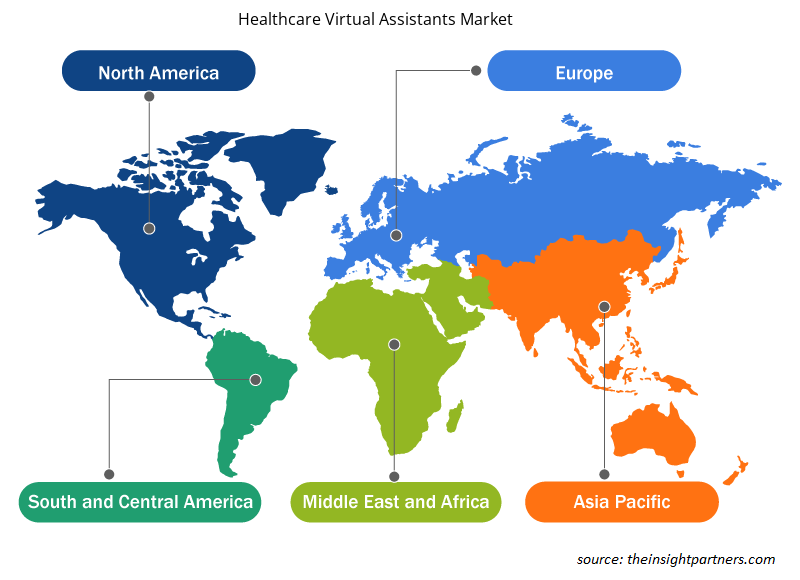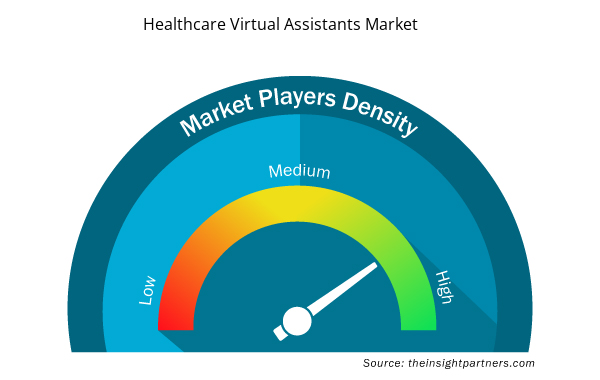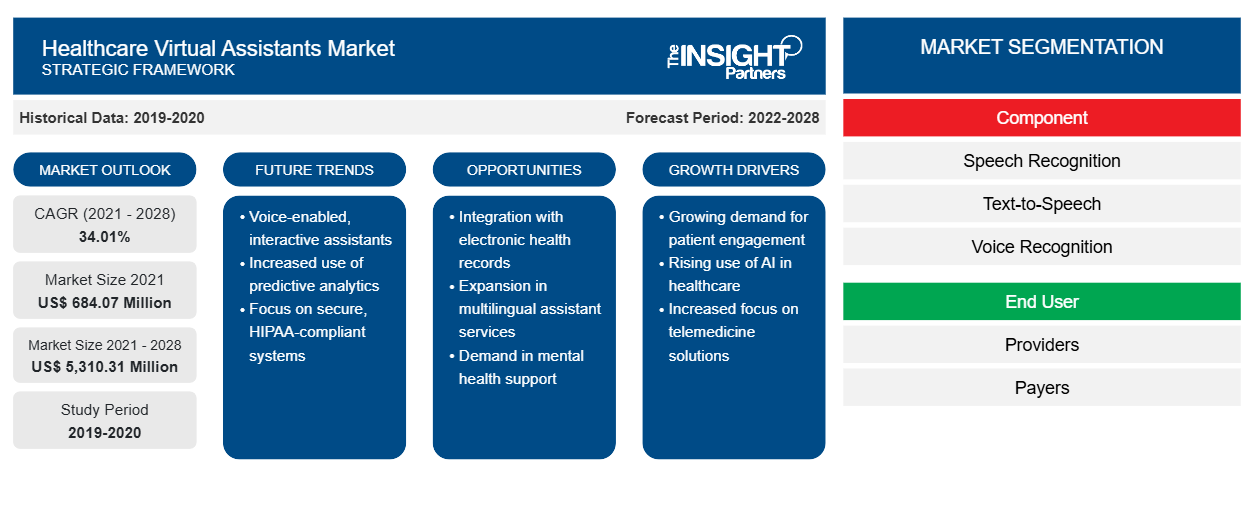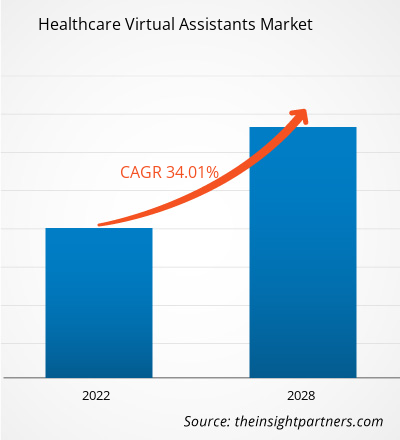[Informe de investigación] Se proyecta que el mercado de asistentes virtuales de atención médica alcance los US$ 5.310,31 millones para 2028 desde los US$ 684,07 millones en 2021; se espera que crezca a una CAGR del 34,01% entre 2021 y 2028.
El aumento de los avances y desarrollos en las soluciones de TI para el cuidado de la salud y la creciente adopción de teléfonos inteligentes con aplicaciones asociadas al cuidado de la salud estimulan el crecimiento general del mercado. Según el informe de la Asociación Estadounidense de Gestión de Información de Salud (AHIMA), los profesionales médicos han surgido como un mercado al que apuntan las tecnologías de teléfonos inteligentes. En las organizaciones de atención médica, como los hospitales, los teléfonos inteligentes avanzados brindan más comodidad y eficiencia que las computadoras tradicionales. El informe de la Organización Mundial de la Salud (OMS) afirma que la salud móvil (mHealth) puede revolucionar los resultados de salud entre los pacientes y brindar un servicio virtual a través de un teléfono inteligente con experiencia y conocimiento médico en tiempo real, lo que actúa como una bendición, particularmente para quienes viven en áreas remotas.
Personalice este informe según sus necesidades
Obtendrá personalización en cualquier informe, sin cargo, incluidas partes de este informe o análisis a nivel de país, paquete de datos de Excel, así como también grandes ofertas y descuentos para empresas emergentes y universidades.
- Obtenga las principales tendencias clave del mercado de este informe.Esta muestra GRATUITA incluirá análisis de datos, desde tendencias del mercado hasta estimaciones y pronósticos.
Es probable que América del Norte continúe dominando el mercado de asistentes virtuales de atención médica durante 2021-2028. Estados Unidos tiene la mayor participación de mercado en esta región. Se espera que el país continúe siendo un accionista dominante en el mercado durante el período de pronóstico debido al desarrollo de la infraestructura de TI de atención médica y las iniciativas gubernamentales para implementar tecnologías de asistentes virtuales de atención médica. Además, Estados Unidos es el mercado más grande para asistentes virtuales de atención médica principalmente debido a la alta demanda de instalación de estos dispositivos avanzados en hospitales y clínicas y atención médica domiciliaria en Estados Unidos debido al aumento de la población geriátrica. Aparte de eso, la presencia de los principales actores competitivos en esta región con sus lanzamientos de productos innovadores presenta oportunidades lucrativas para el crecimiento del mercado regional. En enero de 2019, el Hospital Presbiteriano de Nueva York y Philips anunciaron la colaboración para asistentes virtuales de atención médica. El Hospital Presbiteriano de Nueva York ha planeado expandir sus capacidades de atención virtual con servicios de monitoreo remoto de Philips.
Perspectivas del mercado
La creciente adopción de chatbots y robots de salud para una atención de calidad al paciente impulsa el crecimiento del mercadoHealthbots/Chatbots for Quality Patient-Care Drives Market Growth
La pandemia de COVID-19 es un factor independiente responsable del crecimiento del mercado general de asistentes virtuales de atención médica. Según el informe del Foro Económico Mundial (WEF), el potencial de los asistentes virtuales está enormemente asociado con beneficios lucrativos que ya se están obteniendo. Por lo tanto, el sector de la salud presenta una de las oportunidades más amplias para los asistentes virtuales. Por ejemplo, los recordatorios de citas por texto automatizados y la asistencia mediante chatbots están ayudando a los médicos a conectarse con los pacientes a través de consultas digitales. Para que conste, en Ruanda, donde solo hay un médico y seis trabajadores de la salud por cada 10.000 personas, los bots de salud están ayudando a reducir la gran demanda de personal sanitario. En los próximos años, los bots de salud se convertirán en la herramienta central al utilizar IA localizada para el idioma y la epidemiología de Ruanda para permitir que más pacientes sean atendidos para la consulta. Por lo tanto, a través de estos asistentes virtuales, se puede lograr un uso eficaz de los escasos recursos de salud y, a cambio, se mejorará la calidad de la atención y se podrá mantener informados a los trabajadores de la salud.WEF) report, virtual assistants' potential is enormously associated with lucrative benefits that are already being realized. Therefore, the healthcare sector presents one of the most extensive opportunities for virtual assistants. For example, automated text reminders of appointments and chatbots assistance are helping physicians to connect with patients through digital consultations. For the record, in Rwanda, where there is only one doctor and six healthcare workers per 10,000 people, health bots are helping to reduce the heavy demand on healthcare staff. In the coming years, health bots will become the center tool by utilizing AI localized for Rwandan language and epidemiology for allowing more patients to get served for consultation. Therefore, through such virtual assistants, effective use of scarce health resources can be achieved, and in return, the quality of care will be improved, and healthcare workers can be kept in the loop.
Información basada en componentes
Según el componente, el mercado de asistentes virtuales de atención médica se segmenta en reconocimiento de voz, texto a voz y reconocimiento de voz . Se estima que el segmento de reconocimiento de voz representará la mayor participación de mercado durante 2021-2028. La tecnología de reconocimiento de voz ha ganado una atención significativa en el sector de la salud. Según el informe de la Fundación AHIMA, el sector de la salud comenzó a implementar tecnología de reconocimiento de voz para informes médicos. Con las mejoras continuas en la tecnología, se hizo necesario que los hospitales concientizaran y creyeran en el valor de estos sistemas. En los próximos años, la tecnología de reconocimiento de voz también podría desempeñar un papel importante en beneficiar a los proveedores de atención médica para crear documentos junto a la cama del paciente hospitalizado. Los factores mencionados anteriormente impulsan el crecimiento del mercado para el segmento de reconocimiento de voz.AHIMA Foundation report, the healthcare sector started implementing benefitting healthcare providers to create documents at the inpatient bedside. The factors mentioned above drive the market growth for the speech recognition segment.
Información para el usuario final
Según el usuario final, el mercado se segmenta en proveedores, pagadores y otros. El segmento de proveedores dominará el mercado en los próximos años. Según el informe de la Asociación Estadounidense de Telemedicina (ATA), los asistentes virtuales de atención médica poseen numerosas ventajas para los pacientes y los proveedores. Por ejemplo, al eliminar las barreras físicas para la atención, los proveedores pueden ampliar su alcance mediante el uso de asistentes virtuales, en particular para los pacientes que viven en áreas rurales. Además, puede ofrecer servicios preventivos que permitan la educación del paciente o el asesoramiento sobre bienestar en relación con problemas de salud y bienestar que no sean de emergencia. La expansión de la atención médica virtual puede ayudar a los proveedores a monitorear y administrar la atención de sus pacientes durante su recuperación después de una visita prolongada al hospital o un procedimiento quirúrgico o incluso actuar como un sustituto de la prestación de atención en persona en función de las necesidades de la población de pacientes, las capacidades de la organización de salud y la disponibilidad de recursos. Los factores mencionados anteriormente contribuyen al crecimiento del mercado para el segmento de proveedores.
Las empresas que operan en el mercado de asistentes virtuales de atención médica adoptan la estrategia de innovación de productos para satisfacer las cambiantes demandas de los clientes en todo el mundo, lo que también les permite mantener su marca en el mercado global.
Segmentación del mercado de asistentes virtuales en el ámbito sanitario
Según los componentes, el mercado de asistentes virtuales para el cuidado de la salud se segmenta en reconocimiento de voz, conversión de texto a voz y reconocimiento de voz. Por usuario final, el mercado se segmenta en proveedores, pagadores y otros.
Perspectivas regionales del mercado de asistentes virtuales en el ámbito sanitario
Los analistas de Insight Partners explicaron en detalle las tendencias y los factores regionales que influyen en el mercado de asistentes virtuales de atención médica durante el período de pronóstico. Esta sección también analiza los segmentos y la geografía del mercado de asistentes virtuales de atención médica en América del Norte, Europa, Asia Pacífico, Medio Oriente y África, y América del Sur y Central.

- Obtenga datos regionales específicos para el mercado de asistentes virtuales de atención médica
Alcance del informe de mercado de asistentes virtuales en el ámbito sanitario
| Atributo del informe | Detalles |
|---|---|
| Tamaño del mercado en 2021 | US$ 684,07 millones |
| Tamaño del mercado en 2028 | US$ 5.310,31 millones |
| CAGR global (2021-2028) | 34,01% |
| Datos históricos | 2019-2020 |
| Período de pronóstico | 2022-2028 |
| Segmentos cubiertos | Por componente
|
| Regiones y países cubiertos | América del norte
|
| Líderes del mercado y perfiles de empresas clave |
|
Densidad de participantes en el mercado de asistentes virtuales de atención médica: comprensión de su impacto en la dinámica empresarial
El mercado de asistentes virtuales para el cuidado de la salud está creciendo rápidamente, impulsado por la creciente demanda de los usuarios finales debido a factores como la evolución de las preferencias de los consumidores, los avances tecnológicos y una mayor conciencia de los beneficios del producto. A medida que aumenta la demanda, las empresas amplían sus ofertas, innovan para satisfacer las necesidades de los consumidores y aprovechan las tendencias emergentes, lo que impulsa aún más el crecimiento del mercado.
La densidad de actores del mercado se refiere a la distribución de las empresas o firmas que operan dentro de un mercado o industria en particular. Indica cuántos competidores (actores del mercado) están presentes en un espacio de mercado determinado en relación con su tamaño o valor total de mercado.
Las principales empresas que operan en el mercado de asistentes virtuales de atención médica son:
- Comunicaciones Nuance, Inc.
- Amazon.com, Inc.
- Sistemas Verient, Inc.
- Corporación Microsoft
- Corporación Egain
Descargo de responsabilidad : Las empresas enumeradas anteriormente no están clasificadas en ningún orden particular.

- Obtenga una descripción general de los principales actores clave del mercado de asistentes virtuales de atención médica
Por geografía
Según la geografía, el mercado de asistentes virtuales de atención médica se segmenta principalmente en América del Norte, Europa, Asia Pacífico, Medio Oriente y África (MEA) y América del Sur y Central. El mercado en América del Norte se segmenta a su vez en Estados Unidos, Canadá y México. El mercado europeo de asistentes virtuales de atención médica se subsegmenta en Francia, Alemania, Reino Unido, España, Italia y el resto de Europa. El mercado en Asia Pacífico se subsegmenta en China, India, Japón, Australia, Corea del Sur y el resto de APAC. El mercado de asistentes virtuales de atención médica en MEA se segmenta a su vez en Arabia Saudita, Emiratos Árabes Unidos, Sudáfrica y el resto de MEA. El mercado en América del Sur y Central se segmenta en Brasil, Argentina y el resto de América del Sur y Central.
Perfiles de empresas
- Comunicaciones Nuance, Inc.
- Amazon.com, Inc.
- Sistemas Verient, Inc.
- Corporación Microsoft
- CORPORACIÓN EGAIN
- Infermedica
- Corporación CSS
- Conocido
- Babilonia
- Imagen verdadera interactiva Inc.
- Análisis histórico (2 años), año base, pronóstico (7 años) con CAGR
- Análisis PEST y FODA
- Tamaño del mercado Valor/volumen: global, regional, nacional
- Industria y panorama competitivo
- Conjunto de datos de Excel



Report Coverage
Revenue forecast, Company Analysis, Industry landscape, Growth factors, and Trends

Segment Covered
This text is related
to segments covered.

Regional Scope
North America, Europe, Asia Pacific, Middle East & Africa, South & Central America

Country Scope
This text is related
to country scope.
Preguntas frecuentes
Growing prevalence of chronic diseases and increasing social networking and smart phone users are the most significant factors responsible for the overall market growth.
Based on component, speech recognition segment took the forefront lead in the worldwide market by accounting largest share in 2020 and is expected to continue to do so till the forecast period.
A healthcare virtual assistant is an innovative technology which helps with administrative and customer support tasks such as digitizing health history forms, electronic medical record (EMR/EHR) data management, patient appointment scheduling, medical authorizations, eligibility processing, and medical billing.
The providers segment dominated the global healthcare virtual assistants’ market and accounted for the largest market share of 51.53% in 2021.
Global healthcare virtual assistants’ market is segmented by region into North America, Europe, Asia Pacific, Middle East & Africa, and South & Central America. In North America, the U.S. is the largest market for fall management market. The US is estimated to hold the largest share in the healthcare virtual assistants’ market during the forecast period. The presence of top players and favorable regulations related to product approvals coupled with commercializing new products are the contributing factors for the regional growth. Additionally, the increasing number of R&D activities is the key factor responsible for the Asia-Pacific regional growth for healthcare virtual assistants accounting fastest growth of the region during the coming years.
Nuance Communications, Inc.; Amazon.com, Inc.; Verient Systems, Inc.; Microsoft Corporation; EGAIN CORPORATION; Infermedica; CSS Corp; Kognito; Babylon; and True Image Interactive Inc. are among the leading companies operating in the global healthcare virtual assistants’ market
Trends and growth analysis reports related to Technology, Media and Telecommunications : READ MORE..
The List of Companies - Healthcare Virtual Assistants Market
- Nuance Communications, Inc.
- Amazon.com, Inc.
- Verient Systems, Inc.
- Microsoft Corporation
- Egain Corporation
- Infermedica
- CSS Corp
- Kognito
- Babylon
- True Image Interactive Inc.
The Insight Partners performs research in 4 major stages: Data Collection & Secondary Research, Primary Research, Data Analysis and Data Triangulation & Final Review.
- Data Collection and Secondary Research:
As a market research and consulting firm operating from a decade, we have published and advised several client across the globe. First step for any study will start with an assessment of currently available data and insights from existing reports. Further, historical and current market information is collected from Investor Presentations, Annual Reports, SEC Filings, etc., and other information related to company’s performance and market positioning are gathered from Paid Databases (Factiva, Hoovers, and Reuters) and various other publications available in public domain.
Several associations trade associates, technical forums, institutes, societies and organization are accessed to gain technical as well as market related insights through their publications such as research papers, blogs and press releases related to the studies are referred to get cues about the market. Further, white papers, journals, magazines, and other news articles published in last 3 years are scrutinized and analyzed to understand the current market trends.
- Primary Research:
The primarily interview analysis comprise of data obtained from industry participants interview and answers to survey questions gathered by in-house primary team.
For primary research, interviews are conducted with industry experts/CEOs/Marketing Managers/VPs/Subject Matter Experts from both demand and supply side to get a 360-degree view of the market. The primary team conducts several interviews based on the complexity of the markets to understand the various market trends and dynamics which makes research more credible and precise.
A typical research interview fulfils the following functions:
- Provides first-hand information on the market size, market trends, growth trends, competitive landscape, and outlook
- Validates and strengthens in-house secondary research findings
- Develops the analysis team’s expertise and market understanding
Primary research involves email interactions and telephone interviews for each market, category, segment, and sub-segment across geographies. The participants who typically take part in such a process include, but are not limited to:
- Industry participants: VPs, business development managers, market intelligence managers and national sales managers
- Outside experts: Valuation experts, research analysts and key opinion leaders specializing in the electronics and semiconductor industry.
Below is the breakup of our primary respondents by company, designation, and region:

Once we receive the confirmation from primary research sources or primary respondents, we finalize the base year market estimation and forecast the data as per the macroeconomic and microeconomic factors assessed during data collection.
- Data Analysis:
Once data is validated through both secondary as well as primary respondents, we finalize the market estimations by hypothesis formulation and factor analysis at regional and country level.
- Macro-Economic Factor Analysis:
We analyse macroeconomic indicators such the gross domestic product (GDP), increase in the demand for goods and services across industries, technological advancement, regional economic growth, governmental policies, the influence of COVID-19, PEST analysis, and other aspects. This analysis aids in setting benchmarks for various nations/regions and approximating market splits. Additionally, the general trend of the aforementioned components aid in determining the market's development possibilities.
- Country Level Data:
Various factors that are especially aligned to the country are taken into account to determine the market size for a certain area and country, including the presence of vendors, such as headquarters and offices, the country's GDP, demand patterns, and industry growth. To comprehend the market dynamics for the nation, a number of growth variables, inhibitors, application areas, and current market trends are researched. The aforementioned elements aid in determining the country's overall market's growth potential.
- Company Profile:
The “Table of Contents” is formulated by listing and analyzing more than 25 - 30 companies operating in the market ecosystem across geographies. However, we profile only 10 companies as a standard practice in our syndicate reports. These 10 companies comprise leading, emerging, and regional players. Nonetheless, our analysis is not restricted to the 10 listed companies, we also analyze other companies present in the market to develop a holistic view and understand the prevailing trends. The “Company Profiles” section in the report covers key facts, business description, products & services, financial information, SWOT analysis, and key developments. The financial information presented is extracted from the annual reports and official documents of the publicly listed companies. Upon collecting the information for the sections of respective companies, we verify them via various primary sources and then compile the data in respective company profiles. The company level information helps us in deriving the base number as well as in forecasting the market size.
- Developing Base Number:
Aggregation of sales statistics (2020-2022) and macro-economic factor, and other secondary and primary research insights are utilized to arrive at base number and related market shares for 2022. The data gaps are identified in this step and relevant market data is analyzed, collected from paid primary interviews or databases. On finalizing the base year market size, forecasts are developed on the basis of macro-economic, industry and market growth factors and company level analysis.
- Data Triangulation and Final Review:
The market findings and base year market size calculations are validated from supply as well as demand side. Demand side validations are based on macro-economic factor analysis and benchmarks for respective regions and countries. In case of supply side validations, revenues of major companies are estimated (in case not available) based on industry benchmark, approximate number of employees, product portfolio, and primary interviews revenues are gathered. Further revenue from target product/service segment is assessed to avoid overshooting of market statistics. In case of heavy deviations between supply and demand side values, all thes steps are repeated to achieve synchronization.
We follow an iterative model, wherein we share our research findings with Subject Matter Experts (SME’s) and Key Opinion Leaders (KOLs) until consensus view of the market is not formulated – this model negates any drastic deviation in the opinions of experts. Only validated and universally acceptable research findings are quoted in our reports.
We have important check points that we use to validate our research findings – which we call – data triangulation, where we validate the information, we generate from secondary sources with primary interviews and then we re-validate with our internal data bases and Subject matter experts. This comprehensive model enables us to deliver high quality, reliable data in shortest possible time.


 Obtenga una muestra gratuita de este informe
Obtenga una muestra gratuita de este informe